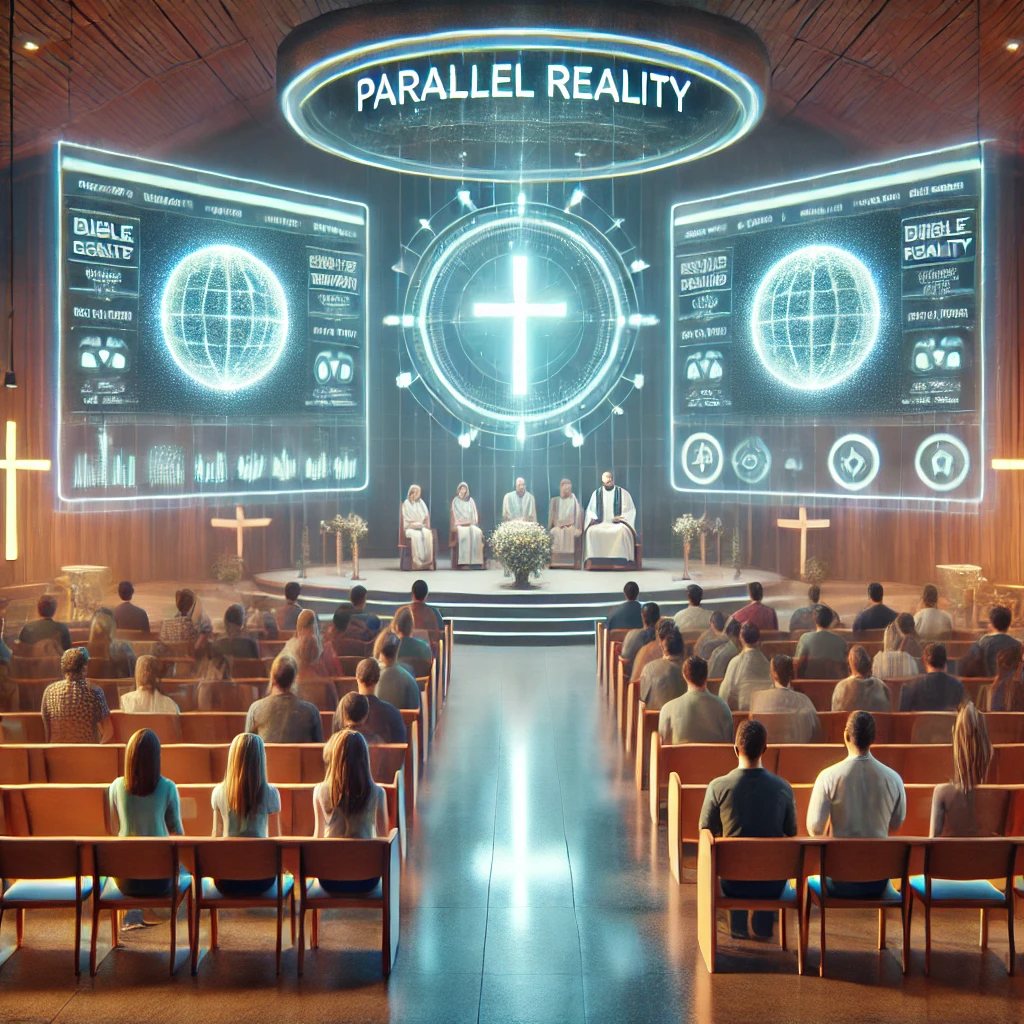Businesses are already embracing this innovative tech to create personalized experiences for their customers. Airports, for example, use Parallel Reality displays to show individualized flight information to each traveler, all on the same screen. Retailers are exploring it to offer custom deals and recommendations tailored to each shopper.
See how Delta is using parallel reality. See article here.
The rapid evolution of technology offers exciting opportunities for churches and ministries to expand their outreach and enhance the experience of their members. One such emerging innovation is parallel reality technology, which allows multiple people in the same space to see unique, personalized digital content on a shared screen. This means that even though everyone is looking at the same display, what each person sees is tailored to them.
Imagine walking into a church lobby and seeing your name on the welcome screen along with personalized information—while the person next to you sees a different message. Parallel reality has incredible potential for ministry environments, enabling deeper engagement, improved communication, and personalized experiences. Here’s how ministries can harness this technology to create richer connections within their congregation and community.
1. Personalized Welcome Messages and Announcements
Parallel reality technology could revolutionize how ministries greet and inform visitors. For example, when attendees walk into the church building, they could be welcomed with personalized messages:
– Regular attendees might see reminders about upcoming events or messages tailored to their past engagement with small groups or volunteer programs.
– Visitors could receive a unique welcome note along with relevant information about how to connect with the church or join a newcomers’ class.
– Those with children could see instructions about where to check in their kids for youth or children’s ministry activities.
This level of personalization makes every member or guest feel seen and valued, creating an immediate sense of belonging.
2. Tailored Worship Experiences
Ministries can elevate worship services with parallel reality by offering **personalized experiences** in real-time. Attendees looking at the same display screen can see content specifically relevant to them:
– **Language customization:** Worshippers from diverse backgrounds can view lyrics, scriptures, or sermon points in their native languages without requiring multiple screens or headphones.
– **Custom prayer reminders:** Individuals could see prayer points they submitted earlier that week or scripture verses related to their personal prayer journey.
– **Quiet room displays:** For parents with young children or individuals in overflow rooms, the system can display relevant announcements or scriptures aligned with the service.
This approach allows each person to engage with worship in a way that is both meaningful and personalized, removing common barriers to inclusion.
3. Enhanced Conferences, Summits, and Retreats
Parallel reality technology can make large ministry events—such as conferences, business summits, and women’s retreats—far more effective. Attendees would no longer need to keep track of complex schedules or maps on their phones. Instead:
– Upon arriving, individuals could see their **personalized schedules** displayed on a shared event screen, including reminders for sessions they signed up for or meal times.
– Volunteers could receive targeted instructions or assignments without disrupting other guests.
– Attendees could be directed to **breakout rooms** or small group discussions relevant to their interests or registration profile, making large gatherings smoother and more enjoyable.
For ministry leaders hosting conferences or multi-day retreats, the ability to provide customized content in real time helps attendees focus on the experience without distractions.
4. Wayfinding and Facility Navigation for Large Churches
Megachurches or ministries with large campuses often struggle to guide people efficiently to the correct places. Parallel reality displays offer a solution by providing **personalized directions** based on each person’s needs:
– Visitors attending for the first time could be guided to key locations, such as the sanctuary or visitor reception area.
– Parents bringing children to Sunday school could see directions to the kids’ check-in desk.
– Members heading to ministry meetings or counseling sessions could receive **navigation support** specific to their activities.
This would greatly enhance accessibility, ensuring that everyone—whether a first-time visitor or long-time member—can easily find their way around the facility.
5. Interactive Sermons and Bible Studies
Parallel reality could transform Bible study and discipleship by offering **customized learning experiences**. Imagine attending a Bible study session where everyone looks at the same display, but the content adjusts based on individual learning paths:
– New believers could see introductory scripture translations and simpler commentaries, while mature Christians see more in-depth theological discussions.
– Participants could view personalized **study plans or follow-up resources** aligned with their spiritual growth.
– Individuals might also receive **Bible verse recommendations** or application points that resonate with specific challenges or prayer requests they’ve shared with ministry leaders.
This interactive approach encourages more meaningful engagement with scripture and fosters a deeper sense of connection within the group.
6. Multilingual Congregational Communication
For ministries serving **multicultural congregations**, parallel reality offers a powerful way to break language barriers. While many churches already use translation devices or multilingual displays, these solutions can feel cumbersome. With parallel reality:
– Attendees can view **sermon notes, announcements, or hymn lyrics** in their preferred language without needing additional screens or headsets.
– Bilingual services become more seamless, with worshippers receiving the same information in the language they understand best.
– This allows everyone—no matter their background—to engage fully in the service, creating a more inclusive environment.
7. Customized Giving Campaigns and Fundraising Initiatives
Many ministries run regular giving campaigns, from capital projects to mission trips and outreach programs. Parallel reality technology can enhance these efforts by **tailoring appeals** to individual members. For example:
– Regular donors might see **thank-you messages** acknowledging their past contributions and updates on projects they’ve supported.
– Occasional givers could receive encouragement to participate in specific causes that align with their interests or past giving history.
– New visitors might see **introductions to giving options** or projects relevant to their personal passions, such as youth outreach or community service.
This personalized approach helps make giving campaigns more meaningful and targeted, which can increase participation and support.
Conclusion: A New Dimension of Ministry Engagement
Parallel reality technology holds tremendous potential for churches and ministries seeking to improve their outreach, personalize worship experiences, and create more engaging events. By offering tailored communication and guidance, ministries can build stronger relationships with their members and visitors.
As this technology becomes more accessible, ministries that adopt it early will set themselves apart by creating seamless, personalized, and welcoming environments. Whether through personalized welcome messages, customized worship content, or multilingual communication, parallel reality technology offers a new way to serve congregations effectively in the digital age.
With the right strategy, ministries can use this innovation not only to **enhance individual engagement** but also to **build deeper connections** within their communities—helping them thrive in a world where technology and faith increasingly intersect.
Schedule a consultation with Loman Creative Services.
Listen to our podcast here.

